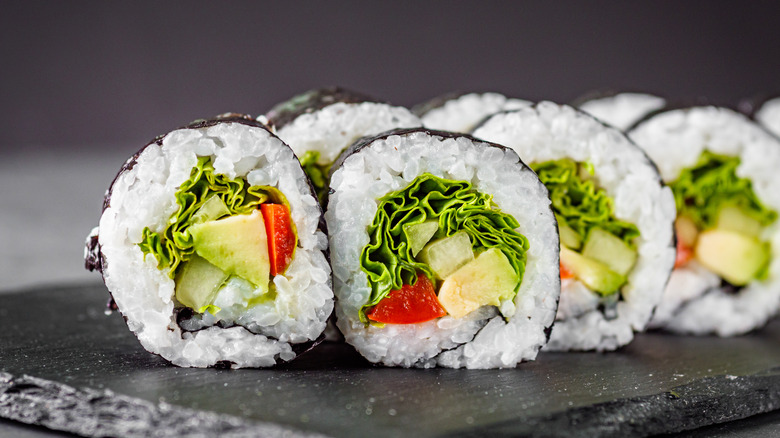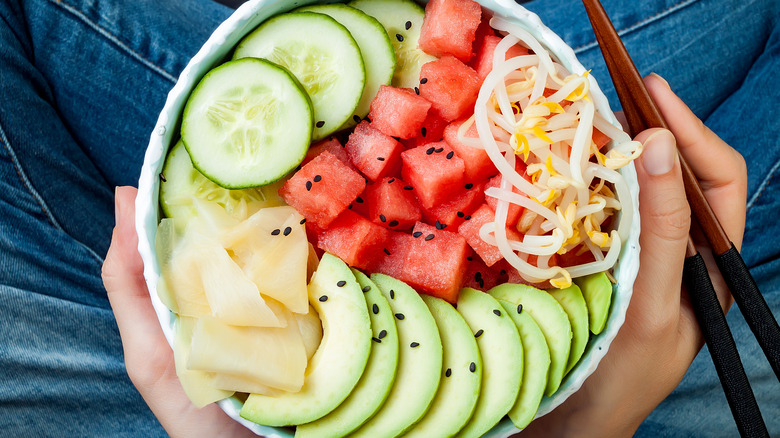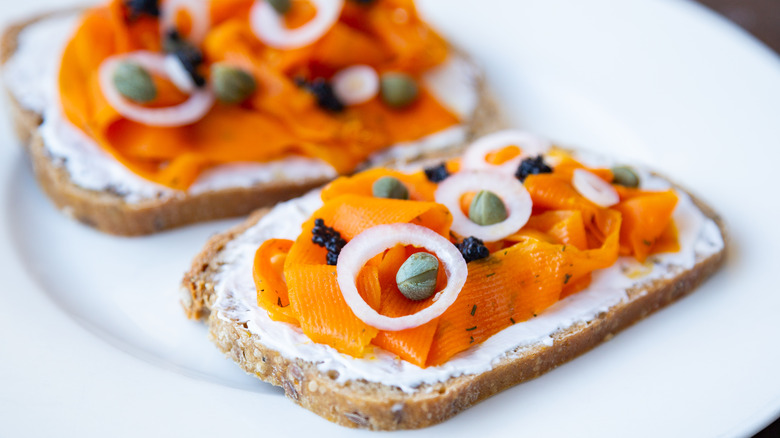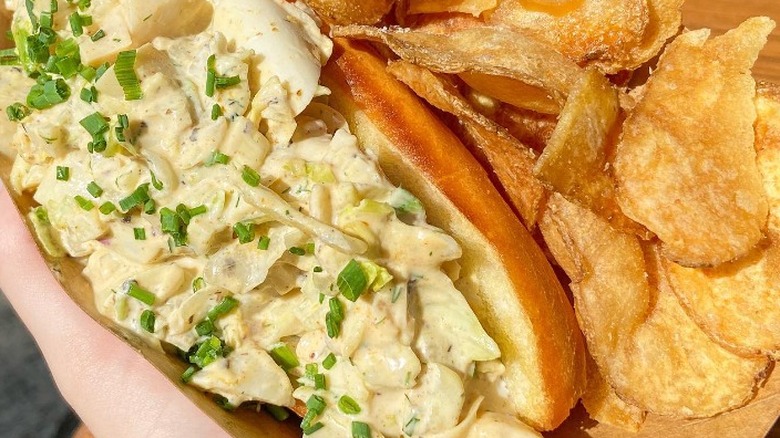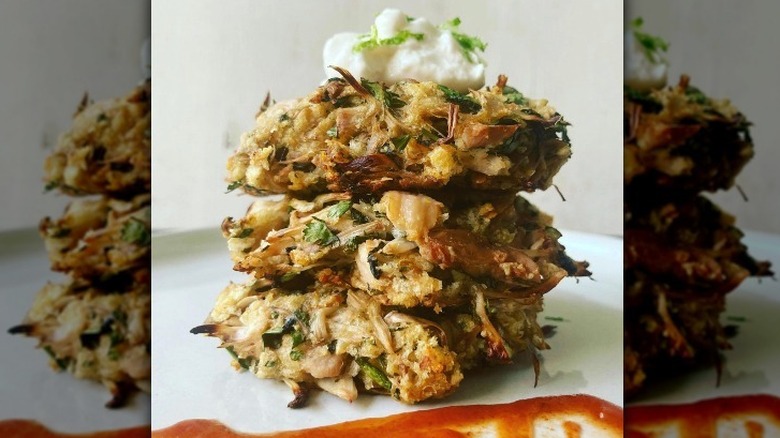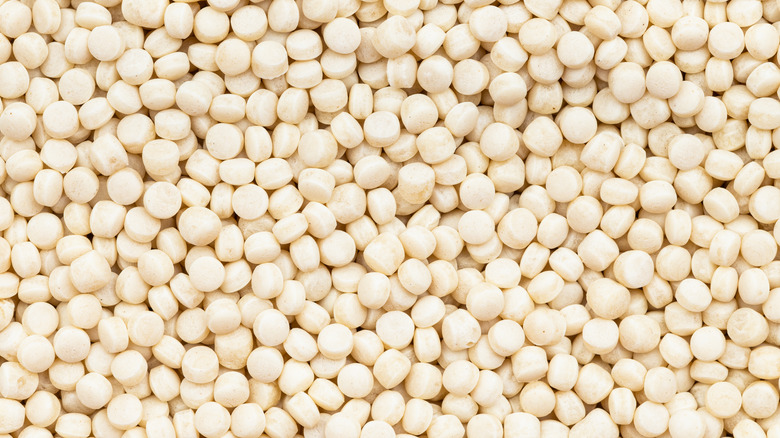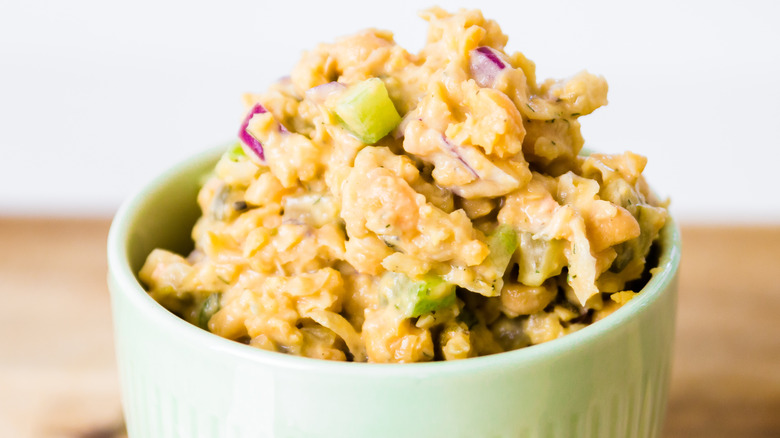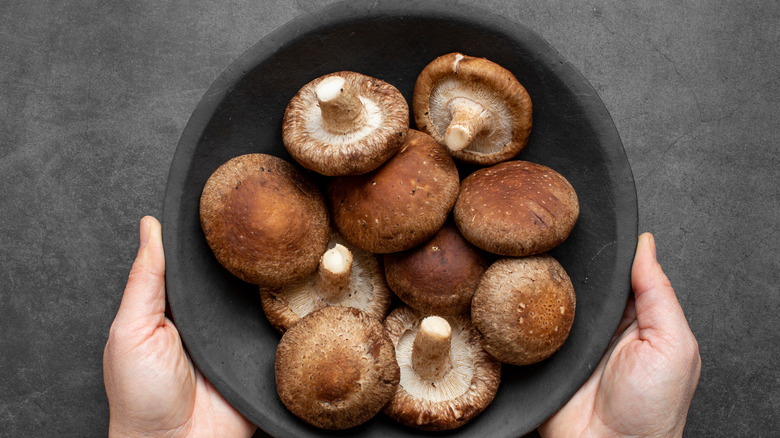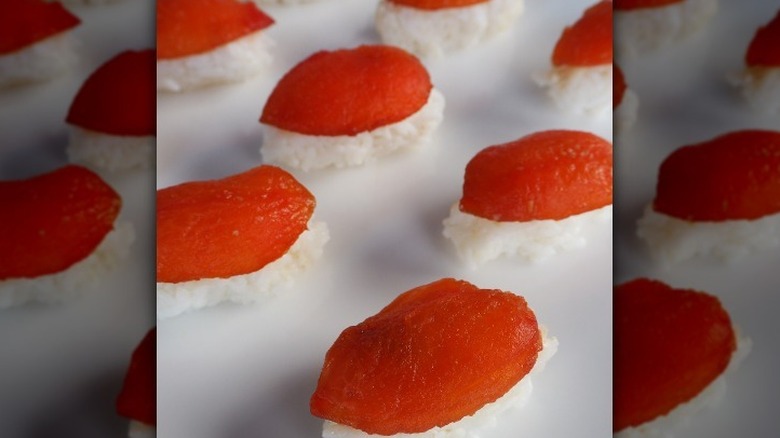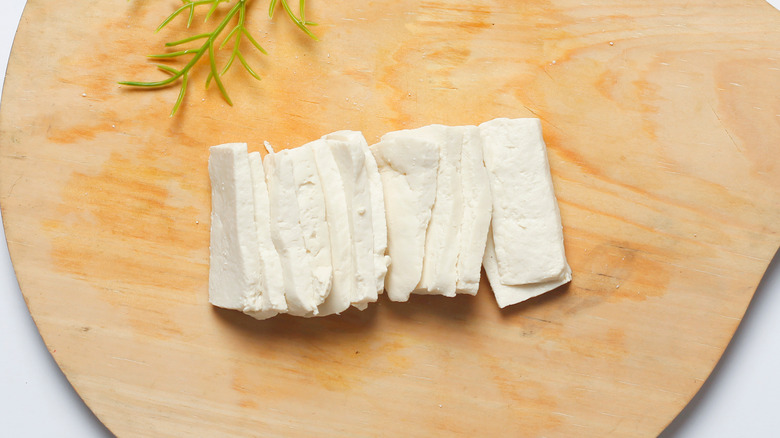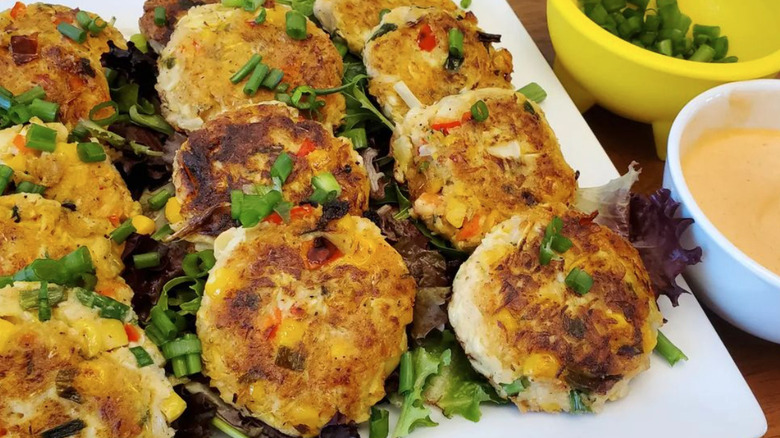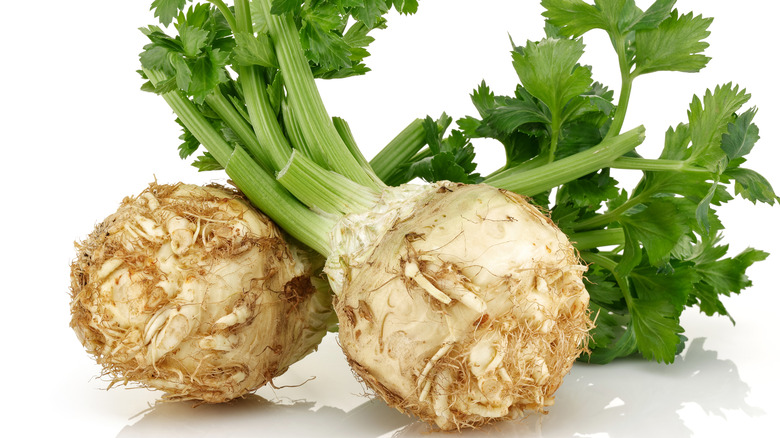12 Plant-Based Seafood Alternatives That Were In Your Cupboard All Along
So, you're trying to eat plant-based? That's exciting! Cutting down or eliminating animal products from your diet can be good for the environment, animals, and agricultural workers — plus, it's probably not going to be a bad thing for your health, either. Yet it can be a difficult transition for plant-based people who used to love seafood. Although there are some plant-based seafood products on the market, these replacements are not quite as easy to find as an Impossible Burger, and sometimes, the mark is missed not only with flavor but also with texture.
What if you could make some of your favorite "seafood" dishes with plant-based ingredients you probably already have at home (or could easily pick up at your local grocery store)? Turns out, that's not just entirely possible — it's also easier than you may be imagining. There are tons of recipes out there that can give you the seafood taste and feel you love ... without killing any fish in the process. That's why we've come up with this list of seafood alternatives you likely already have in your pantry. Take a look, then get creative with your ingredients. You may not even miss seafood at all once you try these recipes.
Watermelon tuna
For those who love raw fish — raw tuna in particular — going plant-based can be difficult. However, we're delighted to inform you that it's possible to make raw "tuna" from watermelon. Raw fish is a notoriously difficult texture to recreate, so you might just be blown away the first time you try vegan tuna made from watermelons. In addition to the watermelon, you're also going to want to snag some ingredients that can lend a fish-like flavor to the fruit: think miso, soy sauce, and nori. The nori is especially important, as it adds a distinct seafood-like note to the dish. You'll then bake the tuna in the oven at relatively low heat until it starts to change textures. Once it comes out of the oven, you might just be shocked at how much it actually looks like real tuna.
You can use this "tuna" for a variety of recipes: Put the stuff in sushi, make a poke bowl, or just eat it on its own as a snack. Once you try it, you'll never even want to go back. Even if you eat actual seafood on a regular basis, this recipe is too fun not to try.
Carrot lox
Miss those salmon-stuffed bagels you used to enjoy so much on the weekends? No worries, because you can make "lox" from carrots — and it's actually a whole lot easier than you're probably thinking. Though some carrot lox recipes rely on liquid smoke to give the carrots the umami flavor that you'd find in actual salmon, you can get away without using it if you have some other ingredients. All you have to do is roast the carrots (with a very generous sprinkling of salt), then let them cool before you cut them into ribbons. Next, you make your marinade: Ingredients like rice vinegar, olive oil, pepper, and lemon juice will lend plenty of flavor to your carrot lox. Yep, that's it! Throw the carrots into the liquid mixture, and let everything sit for around 15 minutes (or longer) before you throw the mixture on your bagel.
The flavor here isn't exactly like real salmon, though we have to admit that the texture really brings it together. Once you add in all the other toppings, like red onion, capers, and cream cheese, you'll find that the carrots blend into the finished product seamlessly.
Hearts of palm lobster
If you've spent much time on the East Coast of the United States, then you know all about the area's seafood culture. Of course, there's the chowder, and you can't forget about oysters. Still, if there's one iconic dish that calls New England home, it has to be the lobster roll. Whether you're more of a hot butter or cold mayo kind of person, it's hard denying that a lobster roll is about as decadent as good seafood can get. So when you're no longer eating lobster, it can be a bummer to feel like you have to miss out on one of your favorites.
Luckily, it's relatively easy to make a delicious vegan "lobster" roll from hearts of palm. Since you can find hearts of palm in a can in just about every grocery store, you can easily whip a recipe up by just shopping in your pantry. All you have to do is chop the hearts of palm into bite-sized pieces, plus mix with other ingredients like celery, paprika, and Old Bay seasoning (which is essential!) to give it some flavor and texture. Toast and butter your roll, then put it all together. You'll be left with a vegan lobster roll that tastes surprisingly like real lobster. The best part? It's way, way cheaper than buying actual lobster anyway.
Jackfruit crab cakes
Anyone who has been eating plant-based for a while is bound to already know that there's a ton of hype around jackfruit. Although jackfruit can be used to make delicious vegan carnitas, that's not all this ingredient is good for. If you've been missing crab cakes and want to look for an alternative, you'll love making jackfruit crab cakes, which are surprisingly easy to throw together. Since you can find jackfruit in either brine or water at your local grocery store (including Trader Joe's, if you have one near you), you'll never be far from everything you need to make the jackfruit crab cakes of your dreams.
First, you'll have to separate the jackfruit from the seeds. Then, you mix it with a hefty dose of Old Bay (yes, it's definitely essential to creating that seafood flavor you know and love) plus a variety of veggies. Form all of the ingredients into little patties, fry it all up, and you have "crab" cakes that aren't too far off from real versions. This is one of our favorite recipes to throw together when we have plant-based family or friends over because these cakes are just the right size for sharing.
Oyster mushroom shrimp and scallops
Now, we can't talk about plant-based seafood without bringing up one of the most important ingredients of all: oyster mushrooms. Oysters are one type of mushroom that is huge in vegan cooking; the ingredient can be used in a huge variety of ways, and because of its texture, it's great for making seafood dishes. One of our favorite ways to use oyster mushrooms is to make plant-based scallops. You can construct delicious vegan scallops with garlic butter sauce; we have to admit that it's one of our all-time favorite ways to prepare these mushrooms. However, that's not the only way you can prepare plant-based scallops: Combine your "scallops" with pasta or try developing a white wine and lemon sauce. Once you know how to work with oyster mushrooms, the possibilities are endless.
Don't limit yourself to vegan scallops. You can also use oyster mushrooms to make fantastic vegan shrimp. The texture here really is spot-on: Oyster mushrooms have that lovely rubbery feel that's similar to many types of seafood, so if that's what you're craving, make sure you keep some oyster mushrooms on hand.
Couscous caviar
There's a reason caviar is so expensive: It has a super distinctive flavor with an unmatched texture that you can't get from other ingredients. Therefore, any attempt to make vegan caviar has to be approached with the assumption that you're not going to find a perfect match for the tiny sturgeon eggs. However, if you're just looking to capture the spirit of the dish, you can't go wrong with vegan "caviar." Luckily, it's not going to cost you hundreds of dollars to make. Instead of utilizing fish eggs, this "caviar" is made from pearl-sized Israeli couscous. You then make a sauce mixture consisting of olive brine, lemon, garlic, or any other ingredients that give the couscous a savory quality.
Does it taste exactly like real caviar? Not really at all. Does it have that lovely salty, seafood-like quality that makes you want to go back for another scoop? Absolutely. The olive brine is an important ingredient here, as it adds that salinity that's essential for bringing the dish together. Plus, since these ingredients are so common, there's an excellent chance you have everything you need to make this plant-based caviar right now. What are you waiting for?
Chickpea tuna salad
On a less fancy but equally as delicious front, there's no denying that it's hard to beat the utter delight of a good tuna salad. Put it on bread, put it on crackers, or eat it with a fork — regardless of how you consume it, it's a salad that's hard not to love. Part of the fun is that there are many kinds of tuna for making tuna salad, and now there's one more option. For those who have given up on tuna entirely (or who just aren't feeling fishy at the moment), chickpea tuna salad is a solid option. In fact, we may even like it better than the real thing.
There are countless recipes for chickpea "tuna" salad out there. Nearly all start out by instructing you to mash your chickpeas until you've reached a chunky consistency. This is what creates a distinctly tuna-like texture. Then, you can add in whatever else you would normally pair with tuna salad. We like chopped celery, red onion, mayo, and plenty of salt and pepper — feel free to get creative with whatever additions sound best to you.
This recipe is so easy that it's quickly become one of our staples on busy days when we want lunch fast. After all, who doesn't love a simple, plant-based recipe that utilizes a staple ingredient that many of us always keep in the pantry? If you're fully vegan, skip the mayo by swapping it out with avocado.
Shitake fish
We've already touched on the fact that oyster mushrooms have the perfect texture to mimic seafood. It shouldn't come as a surprise, then, that other mushrooms can fill that role as well. Although you can use shitake as a replacement for all types of fish, it works exceptionally well in some instances — like, for example, shitake nigiri.
All you need are some shitake caps, sesame oil, and sauces like soy sauce, fish sauce, or mirin. Thai chilies can add some much-needed heat to the dish if you're into that kind of thing. Make the sushi rice, then cook your shitake mushrooms — you want to develop a chewy, seafood-like consistency. When the mushrooms are done, and your rice has cooled, construct your nigiri. It takes a bit of practice, but once you get it, you'll realize that the whole process is relatively simple.
Not only is shitake fish delicious — it's also a lot more affordable than ordering fish-centric sushi at your favorite local Japanese restaurant. The next time you're craving sushi, this is a no-brainer recipe that shouldn't take too long to throw together.
Tomato tuna
Not feeling the whole watermelon tuna thing? We get it — watermelon isn't everyone's favorite, and it can seem strange to take a sweet fruit and turn it into something that's supposed to be supremely savory. If you're still looking for a plant-based tuna recipe, though, you shouldn't look any further than tomato tuna. Yes, you can use tomatoes to make a tuna-like topping that's delicious in poke bowls and beyond. You might be surprised at just how spot-on the texture is when you use tomatoes to make "tuna."
You'll need to start with Roma tomatoes, as these nightshades have the best shape for the intended application. Then, make sure you have soy sauce, sake, and mirin on hand. Perhaps the most important part, though, is the kombu dashi granules. This ingredient can be found in most Asian grocery stores and lends a distinct seafood-like flavor to the tomato. Nori plays the same role.
It might sound like it's impossible for all of these ingredients to come together so well to create the tomato-based "tuna" of your dreams, only once you give it a try, you may swear off real tuna entirely (if you haven't already).
Tofu fish sticks
Until now, we've omitted one of the most popular plant-based staples of all time: tofu. Tofu often gets overlooked because many recipes that feature it end up being relatively bland and tasteless. If you know how to handle tofu well, you'll realize that it can actually be really, really delicious — especially when you transform it into "fish" sticks. It's easy to make fish sticks made from tofu, and there are fantastic recipes for it all over the internet.
You're going to want to make sure you use firm tofu, as that will give the sticks the kind of texture you're looking for when you want to recreate fish sticks. As far as seasoning goes, the most important ingredients include that old ubiquitous standard, Old Bay. Because Old Bay is used in so many seafood recipes, it'll give your tofu the distinct saline seafood flavor you're looking for. Additionally, this writer also uses nori, which also imparts a seafood-like flavor. Bring it all together to fry those tofu slices up. You may even realize that you've made something better than the real deal.
Artichoke heart crab cakes
We've already talked about hearts of palm, which boasts a soft texture and a bite that is perfect for replicating seafood. But what about artichokes? Artichoke heart has a similar texture, creating another great option. Since this vegetable is so easy to find in the canned section of the grocery store, you can easily keep tins in your pantry and at the ready to use anytime you need. What better way to use artichoke hearts than to make artichoke heart crab cakes? For those who can't find jackfruit (or who simply don't like it), artichoke hearts offer the perfect alternative. The result will be "crab" cakes that offer a lovely, toothsome texture fit to make you feel like you're actually eating seafood.
Just take your artichoke hearts and combine with ingredients like zucchini, chickpeas, panko breadcrumbs, vegan mayonnaise, and, importantly, Old Bay seasoning. Of course, you can feel free to get as creative as you want here. Don't like zucchini? Leave it out! Choose another veggie to add instead — whatever your intuition says to go with. Once you have all your ingredients picked out, form patties, then bake in the oven. Before you know it, you'll have some of the best plant-based "crab" cakes you've ever tried.
Celeriac fish
Alright, we know what you're thinking: Not everyone has easy access to celeriac. Fortunately, however, this root vegetable is slowly becoming more popular, and there's a good chance you can find it at your local grocery store if you live in a moderately sized city. If you can get your hands on the stuff, you have to try making fish from celeriac. Several recipes online prove that it doesn't have to be as difficult as it sounds.
First, you'll have to cut your celeriac into slices. Basically, you want the parts to be around the size of a piece you would get if you were to order fish and chips at a restaurant. Then, season the celeriac with nori flakes, which lend it some of the salinity of seafood flavor you're going for. Cover it in the batter and get to frying. When it's done, you'll be greeted with a root veggie that actually looks (and even kind of tastes) like fish. For those plant-based noshers who just can't imagine going without their fish and chips, this idea is guaranteed to be a hit.
